
Orchids are plants that belong to the family Orchidaceae, a diverse and widespread group of flowering plants with blooms that are often colourful and fragrant. Orchids are cosmopolitan plants that are found in almost every habitat on Earth except glaciers. The world's richest diversity of orchid genera and species is found in the tropics.

Bulbophyllum is a genus of mostly epiphytic and lithophytic orchids in the family Orchidaceae. It is the largest genus in the orchid family and one of the largest genera of flowering plants with more than 2,000 species, exceeded in number only by Astragalus. These orchids are found in diverse habitats throughout most of the warmer parts of the world including Africa, southern Asia, Latin America, the West Indies, and various islands in the Indian and Pacific Oceans. Orchids in this genus have thread-like or fibrous roots that creep over the surface of trees or rocks or hang from branches. The stem is divided into a rhizome and a pseudobulb, a feature that distinguished this genus from Dendrobium. There is usually only a single leaf at the top of the pseudobulb and from one to many flowers are arranged along an unbranched flowering stem that arises from the base of the pseudobulb. Several attempts have been made to separate Bulbophyllum into smaller genera, but most have not been accepted by the World Checklist of Selected Plant Families.
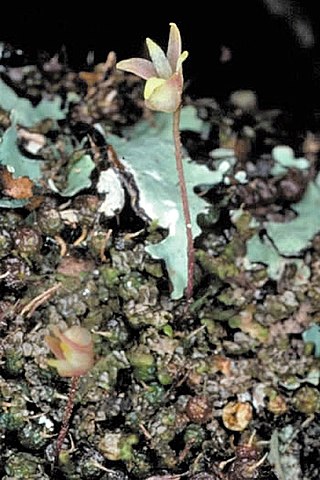
Bulbophyllum globuliforme, commonly known as the green bead orchid, miniature moss-orchid or hoop pine orchid, is a species of epiphytic orchid with tiny spherical pseudobulbs, scale-like leaves and small cream-coloured flowers with a yellow labellum. It grows on the scaly bark of hoop pine, mostly on the McPherson Range on the New South Wales/Queensland border in eastern Australia. Because of its small size it is often dismissed as moss.

Johannes Jacobus Smith was a Dutch botanist who, between years 1905 to 1924, crossed the islands of the Dutch East Indies, collecting specimens of plants and describing and cataloguing the flora of these islands. The standard botanical author abbreviation J.J.Sm. is applied to plants described by J.J. Smith.
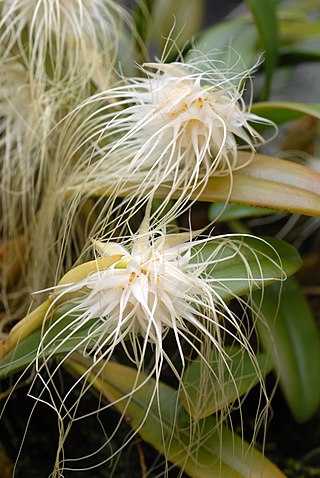
Bulbophyllum medusae, commonly known as the Medusa orchid, is a species of epiphytic orchid with a creeping rhizome and a single leaf about 100 mm (3.9 in) long emerging from the top of each pseudobulb. The flowers are creamy yellow and arranged in clusters of about fifteen arranged in a circle at the tip of the flowering stem. The flowers have an unpleasant odour. The flowers have thread-like lateral sepals about 120 mm (4.7 in) long, giving each cluster the appearance of Medusa.
Bulbophyllum comorianum is a species of orchid in the genus Bulbophyllum. It is a pseudobulbous epiphyte endemic to the island of Grand Comore in the Comoros.
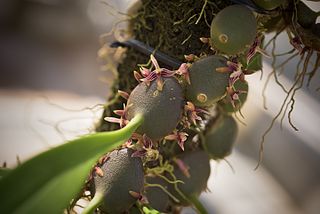
Bulbophyllum cruciatum is a species of orchid in the genus Bulbophyllum found in Papua, Papua New Guinea, Seram Island, and Maluku Islands.

Bulbophyllum exiguum, commonly known as the tiny strand orchid, is a species of epiphytic or lithophytic orchid that is endemic to eastern Australia. It has small, roughly spherical pseudobulbs each with a single leaf and up to three small creamy white to yellow flowers emerging from the base of the pseudobulb. This orchid grows in rainforest and dry forest where it often covers the branches of trees or rocks on which it grows.
Bulbophyllum leonii is a species of orchid in the genus Bulbophyllum. It is a pseudobulbous epiphyte endemic to the Comoro Islands.

Bulbophyllum longiflorum, commonly known as the pale umbrella orchid, is a species of epiphytic or lithophytic orchid. It has a creeping rhizome, widely spaced, dark green pseudobulbs with a single large, fleshy leaf, and flowers spreading in a semicircular umbel, resembling one-half of an umbrella. The flowers are canoe-shaped, greenish cream-coloured to yellowish with purple dots. It has a wide distribution and is found in parts of Africa, on islands in the Indian and Pacific Oceans, Southeast Asia, New Guinea and northern Australia.
Bulbophyllum luckraftii is a species of orchid in the genus Bulbophyllum from the Solomon Islands.
Bulbophyllum mirum is a species of orchid in the genus Bulbophyllum. Its natural distribution is peninsular Thailand, Malaysia, and on Sumatra, Java, Borneo and the Lesser Sunda Islands of Indonesia. It grows in humid montane forests at altitudes from 1,000 m (3,300 ft) to 1,600 m (5,200 ft).

Bulbophyllum odoratum is a species of orchid in the genus Bulbophyllum.

Bulbophyllum plumatum is a species of orchid in the genus Bulbophyllum.
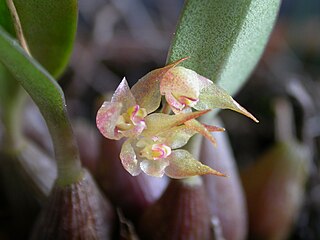
Bulbophyllum scabratum, butterfly egg Bulbophyllum, or Rough Bulb-Leaf Orchid is a species of orchid in the genus Bulbophyllum in section Eublepharon.
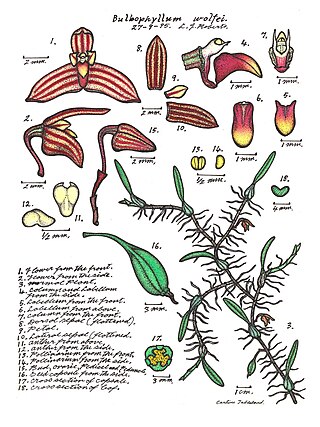
Bulbophyllum wolfei, commonly known as the fleshy snake orchid, is a species of epiphytic or lithophytic orchid with thin, creeping rhizomes, and flattened pseudobulbs each with a single thick, fleshy, dark green leaf and a single cream-coloured flower with dark red stripes. It mostly grows on rainforest trees in tropical North Queensland.
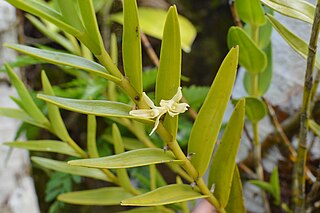
Dendrobium guamense is a species of epiphytic orchid endemic to Guam and the Commonwealth of the Northern Mariana Islands. It is currently known from nine occurrences totaling 550 individuals across the islands of Guam, Rota, Tinian, and Saipan.

Trachoma, commonly known as spectral orchids, is a genus of flowering plants in the family Orchidaceae. Orchids in this genus are epiphytic plants with leafy stems, crowded, leathery leaves arranged in two ranks and a large number of relatively small, short-lived flowers that often open in successive clusters. The sepals and petals are free from and more or less similar to each other, except that the petals are often smaller. The labellum is rigidly fixed to the column and is more or less sac-shaped. There are about 17 species distributed from Assam to the Western Pacific Ocean. Most species grow in rainforests, often on emergent trees such as hoop pine.

Bulbophyllum sect. Codonosiphon is a section of the genus Bulbophyllum.
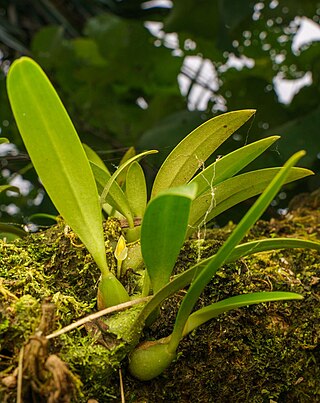
Bulbophyllum raulersoniae is a species of orchid in the section Codonosiphon. It is endemic to the islands of Guam and Rota in the Marianas Archipelago. The species was named posthumously after Dr. Lynn Raulerson, professor of biology at the University of Guam, who had discovered the species in 1986. After going unnamed for 36 years, the species was first described and named in the OrchideenJournal in 2022 by Banjamin Deloso, Charles Paulino, and Jim Cootes.
















